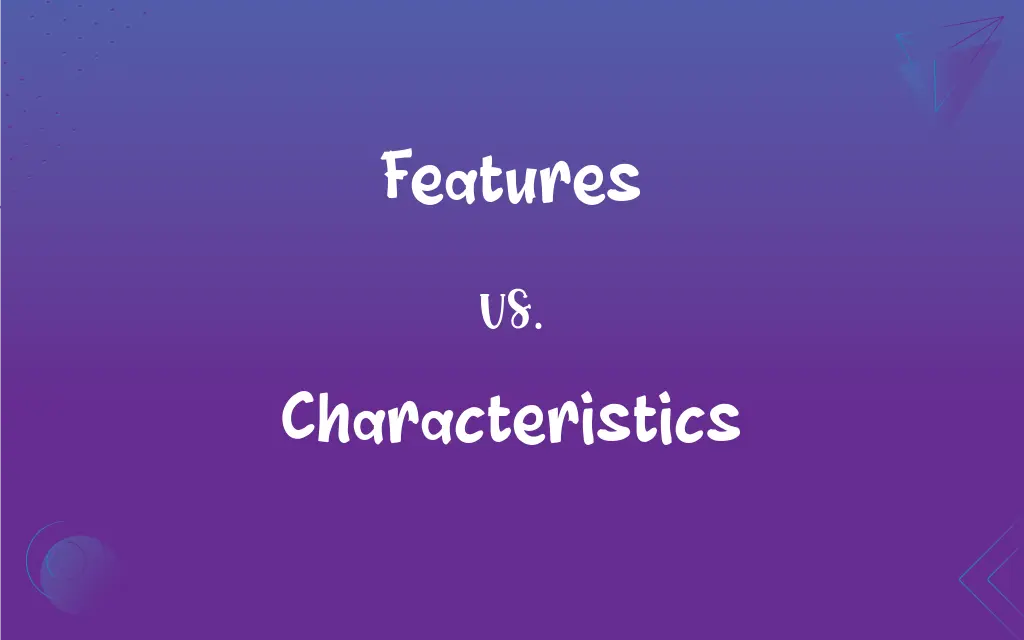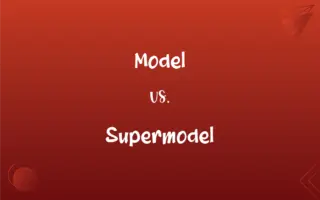Features vs. Characteristics: What's the Difference?
Edited by Janet White || By Harlon Moss || Updated on October 12, 2023
Features are distinctive attributes or aspects, often highlighted for their utility or novelty; characteristics are inherent qualities or traits that define or describe something or someone.

Key Differences
Features generally refer to distinctive attributes or aspects of something that are often highlighted due to their utility or novelty. In many instances, features are presented as selling points, indicating something specially designed or incorporated into a product, service, or entity for particular attention or utilisation. Characteristics, however, are typically inherent qualities or traits that help to define or describe something, not necessarily making them stand out but inherently part of the item, person, or concept.
When we consider features, it often implies aspects that are meant to draw attention or provide specific functionality. In a technological device, for instance, features might include a special camera, an innovative software application, or a unique design element that provides certain advantages or appeals to users. Characteristics would encompass more general qualities, such as the device’s color, weight, or overall ease of use, which are not necessarily highlighted as selling points but describe its inherent nature.
In biological contexts, features might refer to particular attributes of an organism that are notable or have a specific function or purpose. For example, the bioluminescence of certain jellyfish would be considered a feature due to its distinctive and uncommon nature. In contrast, characteristics might involve more basic, descriptive aspects, such as the organism’s color, size, or general morphology, which provide a foundational description but do not inherently indicate something uncommon or noteworthy.
In describing a product like a car, features might include elements like a sunroof, leather seats, or advanced technological components that serve as selling points. These features are generally intended to enhance the appeal of the product and serve as notable points for marketing and sales. Characteristics, conversely, might involve more standardized and expected attributes, such as the car’s color, engine type, or body shape, which are essential for a comprehensive description but aren’t focal points of promotion or sales.
When referring to personal attributes, features might often denote physical aspects that stand out or are particularly noted by others, such as strikingly blue eyes or particularly curly hair. Characteristics, while also descriptive, would delve more into a general description or traits of a person, such as their personality type, general appearance, or inherent tendencies. Both features and characteristics provide a means of description, yet features tend to spotlight something, while characteristics lay a foundational descriptive baseline.
ADVERTISEMENT
Comparison Chart
Definition
Notable or distinctive attributes
Inherent qualities or traits
Purpose
Often highlighted for utility or novelty
Describe or define in a general sense
Usage in Sales/Marketing
Used as selling points
Used for general description
Common Contexts
Technology, products, notable physical attributes
Biology, general product description, personality traits
Highlighting
Typically spotlighted or emphasized
Normally not emphasized or highlighted
ADVERTISEMENT
Features and Characteristics Definitions
Features
In physical descriptions, features refer to prominent or unique physical attributes.
His facial features include a sharp nose and deep-set eyes.
Characteristics
Characteristics describe the typical traits or features that make something recognizable.
The characteristics of classical music involve symphony orchestras and composed pieces.
Features
Features often denote elements that provide specific functionality or appeal.
Modern cars often have features like adaptive cruise control and lane-keeping assistance.
Characteristics
In physics, characteristics can relate to inherent or distinct properties of materials.
The characteristics of copper include high electrical conductivity and a reddish color.
Features
Features refer to distinctive and notable attributes or aspects of something.
The smartphone’s features include facial recognition and wireless charging.
Characteristics
Characteristics pertain to distinctive, inherent qualities that define or describe entities.
The characteristics of an oak tree include strong wood and lobed leaves.
Features
Features in products or services are typically highlighted as selling points.
The software’s features are designed to enhance user productivity and data management.
Characteristics
In biology, characteristics denote identifiable, innate traits of an organism or species.
The characteristics of mammals include having hair and bearing live young.
Features
Features can be inherent or specially incorporated attributes that draw attention or provide utility.
The features of this model include a high-definition camera and ample storage space.
Characteristics
Characteristics may refer to notable aspects of a personality or demeanor.
His characteristics of honesty and diligence are well-regarded.
Features
Any of the distinct parts of the face, as the eyes, nose, or mouth.
Characteristics
Being a feature that helps to distinguish a person or thing; distinctive
Heard my friend's characteristic laugh.
The stripes that are characteristic of the zebra.
Features
Often features The overall appearance of the face or its parts.
Characteristics
A feature that helps to identify, tell apart, or describe recognizably; a distinguishing mark or trait.
Characteristics
(Mathematics) The integral part of a logarithm as distinguished from the mantissa
The characteristic of the logarithm 6.3214 is 6.
Characteristics
(Mathematics) The least number of times the multiplicative identity in a ring needs to be added to itself to reach the additive identity, or, if the additive identity is never reached, zero. The integers have a characteristic of zero; the integers modulo 12 have a characteristic of 12.
Characteristics
Plural of characteristic
FAQs
Can a feature also be a characteristic?
Yes, if a notable attribute (feature) is also inherent or defining (characteristic).
How does a feature differ from a characteristic?
A feature is a distinctive and notable attribute, while a characteristic is an inherent or defining quality.
Are features more prominently used in marketing?
Yes, features are often highlighted as selling points in marketing.
Can characteristics also be physically visible?
Yes, characteristics can be visible, like the color of a car, or intangible, like its reliability.
Are features typically highlighted in product descriptions?
Yes, features are often highlighted to emphasize their functionality or uniqueness.
In technology, what’s an example of a feature?
A high-resolution camera on a smartphone is a technological feature.
Are features more closely linked to functionality?
Often yes, features are highlighted due to their specific functionality or appeal.
Are characteristics observable in every instance?
Not always, some characteristics, like material composition or origin, may not be immediately observable.
Are features usually specific to product types?
Yes, features are typically specific and relevant to the type of product being described.
Can a feature be irrelevant to functionality?
Yes, some features may serve aesthetic or marketing purposes without affecting functionality.
Can characteristics change over time?
Some characteristics can change, like physical aspects due to wear, while others, like material properties, generally remain consistent.
Can characteristics be both positive and negative?
Yes, characteristics can be positive, negative, or neutral, depending on the context.
What’s an example of a characteristic in biology?
A characteristic in biology could be the ability of some reptiles to regenerate lost limbs.
Is a characteristic always inherent?
Characteristics are typically inherent but may vary between individual entities or over time.
Can both features and characteristics be measured?
Yes, both can be measured or described, though the specifics may vary depending on the context.
Can the features of entities evolve over time?
Yes, features can evolve or be modified to enhance or alter functionality, appeal, or value.
Are characteristics critical for identification?
Characteristics are crucial for providing a thorough description and can aid in identification and categorization.
Are features often added to enhance value?
Yes, features are often added or highlighted to enhance the perceived value of something.
Can something have numerous characteristics?
Yes, an entity can possess numerous characteristics defining or describing it.
Do characteristics play a role in categorization?
Yes, characteristics are often used to categorize or define entities within groups or types.
About Author
Written by
Harlon MossHarlon is a seasoned quality moderator and accomplished content writer for Difference Wiki. An alumnus of the prestigious University of California, he earned his degree in Computer Science. Leveraging his academic background, Harlon brings a meticulous and informed perspective to his work, ensuring content accuracy and excellence.
Edited by
Janet WhiteJanet White has been an esteemed writer and blogger for Difference Wiki. Holding a Master's degree in Science and Medical Journalism from the prestigious Boston University, she has consistently demonstrated her expertise and passion for her field. When she's not immersed in her work, Janet relishes her time exercising, delving into a good book, and cherishing moments with friends and family.































































